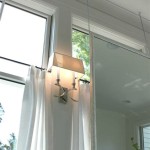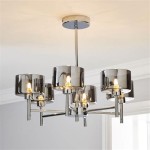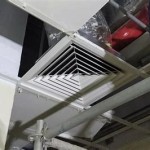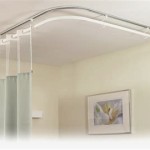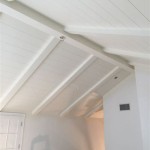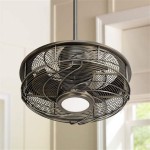Are Nail Pops In Ceiling Dangerous? Examining the Risks and Solutions
Nail pops in ceilings are a common occurrence in many homes, particularly those constructed with drywall. These small blemishes, often appearing as raised bumps or circular depressions, are typically the result of nail or screw heads pushing through the drywall surface. While seemingly minor cosmetic imperfections, understanding the potential dangers associated with nail pops and addressing them promptly is crucial for maintaining the structural integrity and safety of a building.
The primary cause of nail pops is the natural expansion and contraction of building materials due to fluctuations in temperature and humidity. Wood framing, in particular, is susceptible to these changes. As the wood dries and shrinks, the drywall attached to it can shift, causing the fasteners holding the drywall in place to either loosen or push outwards. Improper installation practices, such as using the wrong type or size of fastener, over-driving the fasteners, or insufficient adhesive, can also contribute to the problem.
Beyond aesthetics, nail pops can indicate underlying structural issues or compromised drywall integrity. Determining the root cause of the pops is essential to evaluating the potential dangers they present. A seemingly isolated occurrence might be a minor issue, while widespread nail pops may signal a more serious problem requiring professional attention.
Understanding the Potential Dangers of Nail Pops
While nail pops may appear innocuous, they can pose several potential dangers if left unaddressed. These dangers range from cosmetic issues to more significant structural concerns.
1. Cosmetic Damage and Aesthetic Concerns: The most immediate concern associated with nail pops is their impact on the aesthetics of a room. These unsightly blemishes can detract from the overall appearance of the ceiling, making a room look uncared for and potentially devaluing the property. While merely cosmetic, repeated patching and repainting due to chronic nail pops can become a time-consuming and frustrating maintenance issue.
2. Indicator of Structural Movement: Nail pops can serve as an early warning sign of structural movement within the building. While slight movement is normal, excessive shifting or settling can indicate underlying problems with the foundation, framing, or roof structure. If nail pops are accompanied by other signs of structural issues, such as cracks in walls, uneven floors, or doors and windows that stick, a professional structural engineer should be consulted to assess the situation.
3. Compromised Drywall Integrity: Each nail pop represents a point where the drywall has been weakened. The drywall around the fastener has been stressed and potentially cracked. Over time, this can lead to further cracking and crumbling of the drywall, particularly if the problem is not addressed. In severe cases, this can result in larger sections of drywall becoming loose and potentially detaching from the ceiling.
4. Potential for Water Damage: If a nail pop occurs in an area of the ceiling that is susceptible to water leaks, such as near a roof penetration (e.g., vent pipe, skylight), the compromised drywall can become a pathway for moisture to enter the building. This can lead to mold growth, wood rot, and other forms of water damage, which can be costly to repair and pose health risks. Furthermore, water seeping through nail pops can cause staining and discoloration of the ceiling.
5. Safety Hazard: In extreme cases, if the drywall becomes significantly weakened due to numerous nail pops or other factors, sections of the ceiling could potentially collapse. While rare, this can pose a serious safety hazard, especially if the collapse occurs in a high-traffic area of the home. The potential for falling debris can cause injury and property damage.
Identifying the Causes of Nail Pops
Accurately identifying the cause of nail pops is crucial for implementing effective solutions and preventing recurrence. A thorough inspection of the affected area and the surrounding structure can often reveal the underlying problem.
1. Wood Shrinkage and Expansion: As mentioned earlier, the natural expansion and contraction of wood framing is a primary cause of nail pops. This is particularly common in new construction as the wood dries out and reaches its equilibrium moisture content. The extent of shrinkage will depend on the type of wood used, the climate, and the initial moisture content of the lumber.
2. Improper Installation Techniques: Incorrect installation practices during drywall installation can significantly increase the likelihood of nail pops. This includes using the wrong size or type of fastener for the drywall thickness, over-driving the fasteners (driving them too deep), using insufficient adhesive, or failing to properly support the drywall edges. For example, using nails that are too short or screws with inadequate thread can lead to the fasteners loosening over time.
3. Inadequate Framing: Insufficient or poorly spaced framing members can cause the drywall to flex and move excessively, leading to nail pops. The spacing between studs and joists should comply with building codes and manufacturer recommendations to ensure adequate support for the drywall. If the framing is inadequate, the drywall will be more prone to movement and fastener failure.
4. Structural Movement: As previously discussed, nail pops can be a sign of structural movement in the building. This can be caused by a variety of factors, including foundation settlement, soil erosion, seismic activity, or inadequate drainage. If structural movement is suspected, a professional structural engineer should be consulted to assess the situation and recommend appropriate repairs.
5. Vibration: Constant vibration from nearby traffic, construction activities, or other sources can loosen fasteners and contribute to nail pops. The vibration can cause the drywall to shift and move, gradually weakening the hold of the fasteners. In areas prone to vibration, consider using more robust fasteners or installing vibration-dampening materials.
6. Moisture Issues: High humidity or water leaks can weaken the drywall and cause the fasteners to corrode, leading to nail pops. Moisture can also cause the wood framing to swell and contract, exacerbating the problem. Addressing any moisture issues is crucial for preventing further damage and recurrence of nail pops.
Addressing Nail Pops and Preventing Recurrence
The appropriate method for addressing nail pops will depend on the underlying cause and the severity of the problem. In some cases, a simple cosmetic repair may be sufficient, while in others, more extensive repairs may be necessary.
1. Cosmetic Repair: For minor nail pops that are not indicative of any underlying structural issues, a simple cosmetic repair may be all that is needed. This involves removing any loose drywall around the nail pop, re-securing the drywall with a screw (placed slightly above or below the original nail), applying joint compound to fill the depression, sanding the compound smooth, and painting the repaired area to match the surrounding ceiling.
2. Replacing Fasteners with Screws: A more robust solution is to replace the existing nails with screws. Screws provide a stronger and more secure hold than nails and are less likely to loosen over time. Remove any loose drywall around the nail pop, drive a screw slightly above or below the original nail, and then cover the screw head with joint compound, sand smooth, and paint.
3. Adding Additional Fasteners: If the nail pops are caused by inadequate framing or excessive drywall movement, adding additional fasteners can help to stabilize the drywall and prevent further pops. Space the screws evenly across the drywall surface, ensuring that they are properly secured to the framing members. Consider using drywall adhesive in addition to screws to provide even greater holding power.
4. Addressing Structural Issues: If the nail pops are indicative of underlying structural problems, it is essential to address these issues before attempting to repair the nail pops. This may involve repairing foundation cracks, reinforcing the framing, or correcting drainage problems. Consulting with a structural engineer is crucial to determine the appropriate course of action.
5. Addressing Moisture Issues: If moisture is the cause of the nail pops, it is imperative to identify and repair the source of the leak. This may involve repairing a leaky roof, fixing plumbing leaks, or improving ventilation to reduce humidity levels. Once the moisture issue has been resolved, the damaged drywall can be repaired.
6. Improving Insulation and Ventilation: Proper insulation and ventilation can help to regulate temperature and humidity levels, reducing the amount of expansion and contraction of building materials and minimizing the risk of nail pops. Ensure that the attic is properly insulated and ventilated to prevent excessive heat buildup and moisture accumulation.
7. Using Drywall Adhesive: When installing new drywall, using drywall adhesive in addition to screws or nails can significantly reduce the likelihood of nail pops. Drywall adhesive provides a strong bond between the drywall and the framing members, preventing the drywall from shifting and moving. Apply the adhesive according to the manufacturer's instructions, and ensure that the drywall is properly supported while the adhesive cures.
In summary, while often dismissed as minor cosmetic issues, nail pops in ceilings can indicate a range of potential problems, from superficial blemishes to underlying structural concerns. Understanding the causes, potential dangers, and appropriate solutions for nail pops is crucial for maintaining the safety, integrity, and value of a building. Prompt identification and repair of nail pops can prevent further damage and ensure a safe and aesthetically pleasing environment.

How To Handle Drywall Nail Pops Groundworks

Drywall Nail Pop In Bathroom Ceiling Home Improvement Stack Exchange

What Is Nail Pop It A Sign Of Foundation Issues In My Home Anchor Repair

What Are Nail Pops Why Does It Happen And How To Fix

Why Do Nail Pops Happen In A Ceiling After New Roof Thediyplan

What Is Nail Pop It A Sign Of Foundation Issues In My Home Anchor Repair

Nails Coming Out From Underneath Ceiling Bunnings Work Community

How To Handle Drywall Nail Pops Groundworks

Drywall Nail Pops What Every Homeowner Should Know

What Are Nail Pops They A Sign Of Foundation Issues
Related Posts

